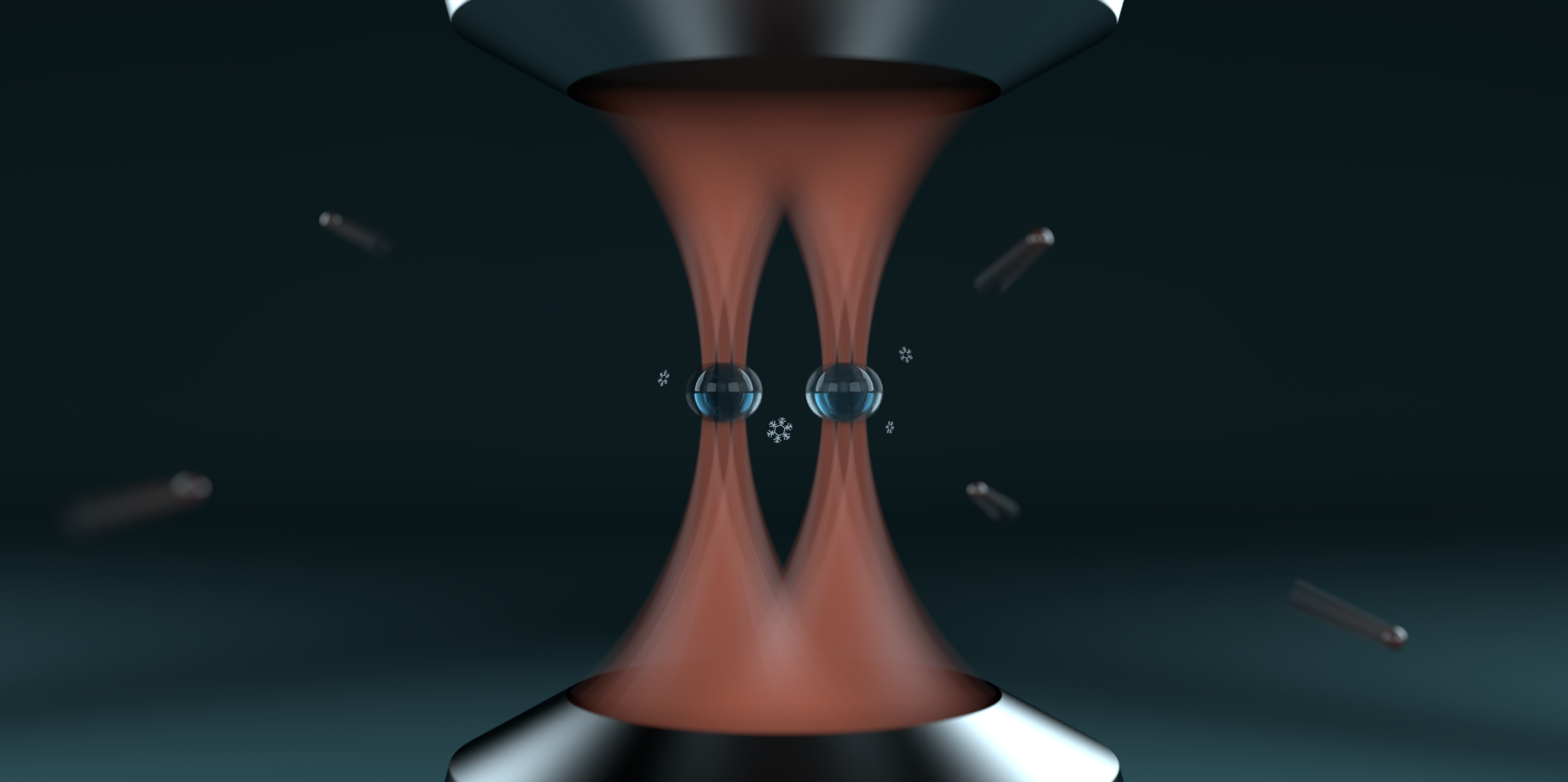Reviewed by Emily Henderson, B.Sc.Nov 22 2022
Scientists at ETH have devised a method for concurrently cooling multiple nanoparticles to temperatures just a few thousandths of a degree above absolute zero. This novel technology can investigate the quantum effects of various nanoparticles and develop very sensitive sensors.
 Using focused laser beams (red), the ETH researchers cool two glass spheres to extremely low temperatures. Image Credit: ETH Zürich / Vijayan Jayadev.
Using focused laser beams (red), the ETH researchers cool two glass spheres to extremely low temperatures. Image Credit: ETH Zürich / Vijayan Jayadev.
Over the last four decades, physicists have learned to cool increasingly bigger objects to near-absolute zero temperatures: atoms, molecules, and, more recently, nanoparticles made up of billions of atoms. While laser light alone may cool atoms, nanoparticles previously required an electric charge and had to be controlled using electric fields for optimal cooling.
A group of ETH scientists headed by Professor Lukas Novotny from the Department of Information Technology and Electrical Engineering has discovered a technique for trapping and cooling multiple nanoparticles independently of their electric charge to a few millikelvin. This opens up new avenues for research into the quantum phenomena of such particles, as well as the development of highly sensitive sensors.
Cooling Neutral Particles
In our research group, we have perfected the cooling of single electrically charged nanoparticles over the past ten years. With the new method, which also works for electrically neutral objects, we can now also trap several particles simultaneously for the first time, which opens up entirely new perspectives for research.
Jayadev Vijayan, Study Lead Author and Postdoc, Department of Information Technology and Electrical Engineering, ETH Zürich
The study was published in the scientific journal Nature Nanotechnology.
In their investigations, the researchers employed a sharply focused laser beam, also known as an optical tweezer, to capture a tiny glass sphere less than 200 nm in size inside a vacuum apparatus. Because of its motional energy, the sphere oscillates back and forth inside the optical tweezer.
The higher the particle’s temperature, the greater its motional energy and, thus, the amplitude of oscillation. A light detector, which collects the laser light dispersed by the sphere, can be used to monitor how forcefully and in which direction the sphere is oscillating inside the optical tweezer at any particular time.
Slowing Down by Shaking
Novotny and his colleagues then used that information to slow down and thereby cool the nanoparticle. This is accomplished by shaking the optical tweezer in the opposite direction of the sphere’s oscillation, using an electronically controlled deflector that significantly changes the direction of the laser beam and, thus, the position of the tweezer.
The deflector swiftly shifts the tweezer to the left when the sphere goes to the right and the right when it moves to the left to counterbalance the sphere's motion. Its oscillation amplitude, and therefore its effective temperature, is gradually lowered in this manner, all the way down to a few thousandths of a degree above absolute zero (−273.15 °C).
The researchers utilized a method to cool two nanoparticles at the same time. The optical tweezers used to trap the spheres are tuned so that the oscillation frequencies of the particles vary slightly. The motions of the two spheres may thus be differentiated using the same light detector, and the cooling-down techniques can be applied to the two tweezers independently.
Scaling up to Several Nanoparticles
The simultaneous cooling can be straightforwardly scaled up to several nanoparticles. Since we have full control over the positions of the particles, we can arbitrarily tune the interactions between them; in that way, in the future, we can study quantum effects of several particles, such as entanglement.
Jayadev Vijayan, Study Lead Author and Postdoc, Department of Information Technology and Electrical Engineering, ETH Zürich
In an entangled state, a measurement of one particle instantly alters the quantum state of the other, despite the fact that the two particles are not in direct contact. Until now, such states have primarily been realized using photons or single atoms. Vijayan wants to be able to construct entangled states with considerably larger nanoparticles one day.
The ability of nanoparticles to remain electrically neutral has additional benefits, such as the construction of incredibly sensitive sensors. When analyzing very weak gravitational interactions between objects or searching for hypothetical dark matter, it is preferable to eliminate as many additional forces as possible, the most common of which are electrostatic forces between charged particles. The ETH researchers' strategy offers fresh perspectives in those sectors as well.
Journal Reference:
Vijayan J. et al. (2022) Scalable all-optical cold damping of levitated nanoparticles. Nature Nanotechnology. doi.org/10.1038/s41565-022-01254-6.